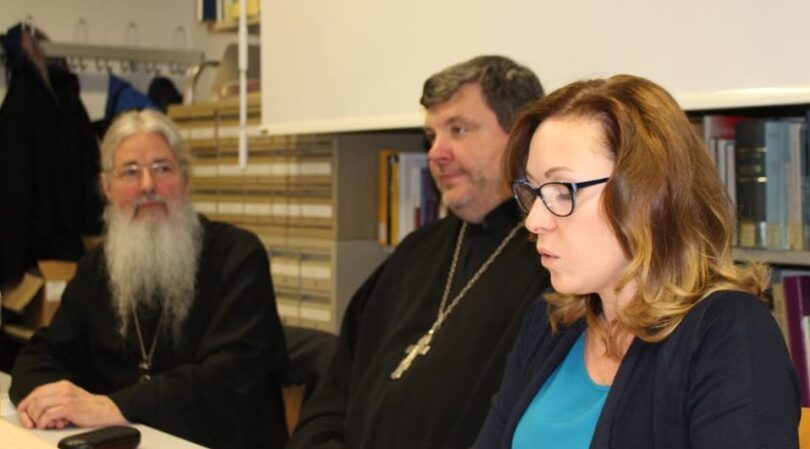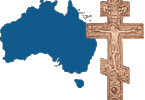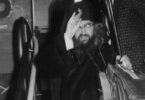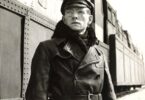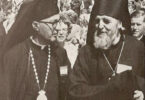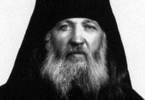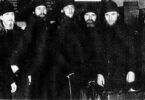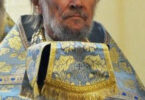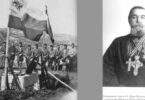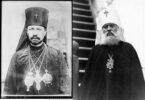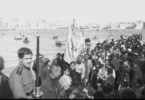Historiography has already presented the problem of the Southeast Russian Church Council’s involvement in politics and its relationship with socio-political organizations during the Civil War. On one hand, the idea of convening the council in order to establish a body of supreme church authority in the south of Russia started to be discussed actively and realized practically within a political party, at the session of the Section on Religious Education of the Council of Governmental Unity of Russia.[1]Kryachko N., prot. Arkhiv Yugo-Vostochnogo russkogo tserkovnogo sobora 1919 g. kak istochnik po istorii Russkoy Pravoslavnoy Tserkvi perioda Grazhdanskoy voyny // Vestnik tserkovnoy istorii. 2012. … Continue reading And this leads to the thought that political and ecclesiastical interests were intertwined. Moreover, researchers note that the council was not of a political nature.[2]Tsvetkov V. Zh. Tserkov’ i vlast’ v gody «Russkoy smuty» (otnoshenie Svyateyshego Patriarkha Tikhona k antibol’shevistskomu dvizheniyu v 1917—1920 gg.) // Belaya gvardiya: … Continue reading Such a seeming contradiction indicates the need for a closer examination of the question regarding what position the SERCC took in the political resistance during the Civil War.
The need to create a supreme Church authority in the part of southern Russia controlled by the White Army was realized, not without the help of Protobresbyter George Shavel’skii, by the Supreme Commander of the Armed Forces, Anton Denikin, who in turn asked Archbishop Mitrophan (Simaskevich) to call together a conference establishing this body.[3]Shavelskiy G., protopr. Vospominaniya poslednego protopresvitera Russkoy armii i flota: V 2 t. N’yu-York: Izd. im. A. P. Chekhova, 1954. V. 2. P. 329. From the protobresbyter’s memoirs it follows that the episcopate approached the idea of creating a supreme body of Church governance with caution, mainly due to canonical misgivings – would such a body be legitimate from a canonical point of view? Finally, on April 27, 1919, an organizational meeting on the problem of establishing a supreme Church authority was held, which was esentially a session of the Section on Religious Education of the Council of Governmental Unity.[4] State Archive of the Russian Federation – Gosudarstvennyi arkhiv Rossiiskoi Federatsii (GARF). F. 3696. Op. 2. D. 4. L. 17-25.
The Council of Governmental Unity of Russia (SGUR) was an anti-Bolshevick organization which proclaimed the restoration of “a great, unified, and undivided Russia.”. At the same time the organization stood for an “unpredetermined” position, i.e. it left the question of the form of government in a Russia free of the Bolsheviks up to a constituent assembly. Such views are essentially in line with the principles of the White Movement.
Members of SGUR, as well as of another socio-political organization, the National Center, were part of the Special Conference which was under the Commander in Chief of the Armed Forces in Southern Russia (AFSR).[5]Butakov Я. А. Osoboe soveshchanie pri Glavnokomanduyushchem vooruzhennymi silami na YUge Rossii (1918-1919.) (http://www.antibr.ru/dictionary/ae_ossov_gk.html (Inquiry date: 14.02.2014)). As protopresbyter, Father George Shavel’skii became a member of SGUR. Included there were former deputies to the State Duma, members of the Provisional Government, representatives of the higher Orthodox clergy, and major entrepreneurs, including Prince E. N. Troubetskoi, a member of SERCC.[6]Molchanov L. А. My ne dali veruyushchim vsego togo, chto dolzhny byli dat’ (Vremennoe vysshee tserkovnoe upravlenie na Yuge Rossii) // Belaya gvardiya: Russkaya Pravoslavnaya Tserkov’ i … Continue reading
The meeting took place at the residence of His Eminence Ioann, bishop of Kuban and Ekaterinodar, and brought together both the clergy and laypeople. Participating were Metropolitan Platon (Rozhdestvenskii) of Kherson, Archbishop Dimitrii (Abashidze) of Tauride, Archbishop Agapit (Vishnevskii) of Ekaterinoslav, Bishop Ioann (Levitskii) of the Kuban, Prince E. N. Troubetskoi, Count Musin-Pushkin, V. M. Skvortsov (a member of the Union of Russian National Communities), as well as representatives of the armed forces – Colonel A. V. Borislavskii, Lieutenant M. Iu. Rodionov, and others.[7]GARF. F. 3696. Op. 2. D. 4. L. 17.
At the organizational meeting the idea was first expressed that a council was necessary to make a decision on such an important issue as the creation of an ecclesiastical governing body. As Protopresbyter G. Shavel’skii wrote, “I have briefly laid out the history of the attempts to develop a supreme Church authority and the necessity of such an authority, while Metropolitan Platon proposed calling together a council to establish such an authority.”[8]Shavelskiy. Ibid., p 331. However, the meeting’s minutes recorded that the necessity of a council was expressed not by Protopresbyter G. Shavel’skii, but by Archpriest. A. Rozhdestvenskii.[9]GARF. F. 3696. Op. 2. D. 4. L. 18 ob. But, one way or another, if the initiative to establish a supreme body of Church authority for southern Russia came from political circles and the White Army leadership, the idea of calling together a council came from within the Church herself.
The White Movement appealed to traditional values, and a leading role was allotted to Russian Orthodoxy. But the creation of a supreme Church authority for southern Russia was not motivated solely by ideology. The leaders of the White Movement placed specific hopes upon it of a practical nature. The Special Conference made it its task to recreate Russia, specifically to reconstruct government organs in the territories under White Army control. As these territories grew, so did the breadth of civil matters. On February 2 (15), 1919, Denikin issued a new “Position Regarding the Special Conference,” according to which confessions were placed under its control.[10]Butakov. Ibid. This meant that Church governance was perceived by the authorities the same way as it was before the Revolution – as part of the governmental apparatus, while the Church was seen as part of the governmental system.
The Anti-Bolshevick forces were rather heterogeneous politically. The Cossacks were in a special position. The Cossack administrative entities – the Don, Kuban, and Terek governments – while being in alliance, had a rather complex relationship with the commander in chief, who maintained the idea of an autocratic military dictatorship. The atamans and military governments of the Don, Kuban, and Terek strove to prevent the spread of the SC’s power in the Cossack regions in matters of civil governance, as a defense of their “sovereignty.”[11]Butakov. Ibid. When the commnader-in-chief’s headquarters was moved to Taganrog and Rostov-on-Don, his relationship with the Kuban rada became strained.[12] Puchenkov A. P. Denikin i Kuban’ v 1919 godu: dva epizoda otnosheniy // Russkiy sbornik: issledovaniya po istorii Rossii. M.: Izdatel’skiy dom “Regnum”, 2012. P. 389. By fall of 1919 this conflict was growing. Thus, the Cossacks were in opposition to the commander in chief, who referred to them only as separatists.[13]Shavelskiy. Ibid., p. 356; Denikin A. I. Ocherki russkoy smuty. Paris, 1921 (http://militera.lib.ru/memo/russian/denikin_ai2/index.html (Inquiry date: 14.02.2014)). So how could the White Army exercise leadership and issue calls for a unified Russia if the White forces themselves were not of one mind? In this situation, the Church had to function as a pacifying and unifying force. Thus, the unification of dioceses under the rule of a general ecclesiastical administration would have been a step toward the governmental unification of territories occupied by the Whites.
In addition, Protopresbyter G. Shavel’skii didn’t fail to mention yet another reason to create the Provisional Supreme Church Administration (PSCA), which was to strengthen the power of the commander in chief of the AFSR. The protopresbyter wrote in his memoirs that the question of the PSCA’s location, which was discussed at the Stavropol Council, was not as insignificant as it might seem. If the PSCA will be in the same place as the commander in chief, this, according to Father Georgii, will serve to reinforce the government’s prestige. “The separatists understood this,” writes Shavel’skii, “and were already planning to pull the PSCA over into the Great Army of the Don.”[14]Shavelskiy. Ibid., p 351. There was a confrontation at the Council between the commander in chief and the army leadership of the Don, the Kuban, and the Terek. Delegates from the Region of the Great Army of the Don protested against the proposal to specify that the location of the PSCA was to be “where the civilian establishments of the White Army will be located,” and threatened that such an outcome will result in a denial of funding “for Church needs.”[15]Ibid., p. 344. According to Protopresbyter G. Shavel’skii the Council decided that the Don delegates were guided by “petty provincial ambition” and ruled that the PSCA would be operating at the commander in chief’s headquarters.[16]Ibid., p. 350.
V. M. Skvortsov, a member of the Union of Russian National Communities, formulated, at the organizational meeting, his vision of the motives justifying the establishment of a supreme body of Church administration:
“Due to the Bolshevik captivity and the persecution of the spiritual head of our Church, His Holiness Patriarch Tikhon, the White Army does not have a document from him blessing its sacrificial feats, which would indicate to the confused and ignorant masses the Church’s prayer-enhanced attitude toward the White Army as a gatherer of the scattered Russian land and a protector of the sacred places and objects of popular faith as well as of the Church, the legal order, and true freedom”.[17]GARF. F. 3696. Op. 2. D. 4. L. 19 ob.
Finding itself in entirely different circumstances than those in the territory occupied by the Bolsheviks, and exercising freedom, the Church administration in southern Russia could function using totally different means and methods from those of the central administration. According to Skvortsov, the Church was expected “to shine her spiritual aureole upon the newly-created Russian Army as one that is Christ-loving,” i.e. to bestow her official blessing of the White Movement, which had not been obtained from the patriarch.[18]Ibid.
Protopresbyter G. Shavel’skii informed Council members of the desire of the secular authorities to activate the Church’s unifying powers to solve the governmental task of recreating a single and undivided Russia.[19]Kryachko. Ibid., p 162. The protopresbyter continued this line of support for the commander in chief at the Council. All efforts by socio-political organizations to enlist the Church’s support and blessing were consistently rejected, not without the protobresbyter’s participation. The address of the council of the Union of Russian National Communities to the Preconciliar Committee included a request to bless its statutes and the entire “cultural and progressive national activity,” as well as to include its representatives as Council members.[20]GARF. F. 3696. Op. 1. D. 1. L. 10-10 ob. The resolution with which Protopresbyter G. Shavel’skii responded to this address precluded any possibility of a positive response and noted that the Council should “have restricted presentations by any deputation.”[21]Ibid. L. 10. The Council ruled that the request of the Council of Russian National Communities should be relegated to the Section on Parishes, and it never was examined due to lack of time.[22]Ibid. L. 18, 73.
Various socio-political forces wished to take advantage of the Council’s authority, and in this way, they directed the Council and the future of the PSCA toward solving political problems. This was expected of the Church. But what position did she take herself?
While in the Preconciliar Committee and at the Council Protobresbyter G. Shavel’skii was inclined to regard Church activity as a means of accomplishing one goal – the restoration of the state, of which one of the basic conditions was the rebirth of parish life.[23]GARF. F. 3696. Op. 1. D. 1. L. 5 ob. At the second session of the Council he noted that “a circumstance of an incomparably higher and ideological order forces us to contemplate the establishment of a supreme Church authority in Southern Russia. Russia is fragmented, she’s fragmented into parts. Civil and spiritual unification is required for these parts, and a Supreme Church Authority can perform a great service in this regard, unifying the fragmented parts of Russia with one thought and power.[24]Ibid. L. 20.
The protoresbyter repeatedly invoked the slogans of the White Movement as well. He gave priority to the role of the state, while the Church turned out to have a secondary subsidiary role. However, if such pragmatic rhetoric was his style, the Council as a whole spoke another language.
In his greeting in response to General A. I, Denikin at the first session of the Council Bishop Mitrophan of the Don and Novocherkassk still did not lump the good of the state and the Church together. He thanked Denikin for holding the fate of the Church as dear as the fate of his native land. At the same time, Denikin’s support was obvious. The commander in chief was called the weapon of God’s providence, while those representatives of the Don and Kuban Armies who had spoken at that same session were termed representatives of the Orthodox population. The contents of their addresses weren’t even recorded in the minutes. And yet they had spoken of an alternate path for the White Movement. Thus, P. S. Yakushev, speaking for the Don Assembly, stated, “Tight unity between neighbors is needed. The idea of a Southeastern union is already being realized in the Church world.”[25]GARF. F. 3696. Op. 2. D. 4. L. 4; Zhizn’. 1919. No. 34. 4 (17) June.
The idea of the commander in chief’s supremacy was reflected in the Council’s address to Denikin. It noted his leading and unifying role, as the Cossack armies also united around him.
The Council was greeted by Ataman V. D. Bogaevskii of the Army of the Don, the All-Russian National Center, the Council of Governmental Unity, and the Central Committee of the Popular Freedom Party.[26]Ibid. Op. 1. D. 1. L. 18. In response they received brief thankful greetings from the Council which emphasized the need to return to faith and to the Church.[27]Ibid. Op. 2. D. 4. L. 26—26 ob.
In spite of the fact that representatives of political organizations who were constantly disposed toward political rhetoric took part in the Council, it strove as a whole to avoid political statements. For example, Priest V. Vostokov’s remarks were judged to be politicized, and he was denied the floor. His political remarks were condemned in the press as well.[28]Zhizn’. 1919. No. 34. 4 (17) June.
In his address to the Council, V. M. Skvortsov turned to the problem that was being discussed in the Church community and which he termed:”politics in the pulpit.” He suggested a distinction between political issues that are unworthy of the Church’s pulpit and issues “of the social-governmental and popular – life of the moment being experienced, which require peremptory illumination by the living word of Gospel truth.”[29]GARF. F. 3696. Op. 2. D. 4. L. 44 ob. In his opinion parish activity should enhance the uniting of ideologically fragmented parishioners and the ideological upbuilding “of the new life of our native land.”[30]Ibid. L. 45. However, the topic Skvortsov raised was not developed further at the Council.
Thus we must agree with A. A. Kostriukov that the Council took a restrained political position, not wishing “to ruin the fragile peace between representatives of various parties that were represented in the White forces.”[31] Kostryukov. Ibid., p 73.
The Council viewed the events taking place in Russia from a from a moral and spiritual perspective. In its opinion moral downfall was the cause of all of the disasters besetting the people. “A great nation has become brutal. The great Russian land is at the brink of destruction,” declared the Council’s address to Denikin.[32]GARF. F. Р-5827. Op. 1. D. 116. L. 2-3. The address to the Kuban Cossacks stated: “Keeping in mind, first of all, the glory of God, remain faithful sons of God’s Church till the end… Only a Christ-loving army can be victorious.”[33]Ibid. F. Р-440. Op. 1. D. 100. L. 87.
The moral breakdown of society was seen by the Council as the essence and the greatest evil of the Revolution. The goal of the Revolution was not the struggle with the “old regime” but with the old faith. “The Revolution is a bloody campaign against Christ,” noted the Council’s message to the Red Army.[34]Ibid. D. 55. L. 61.
But, while rebuking the anti-Christian and anti-human character of the Bolshevist ideology, the Council simultaneously appealed to the commander in chief of the South Russian Armed Forces as well as to the atamans of the Don, Kuban, and Terek Cossack Armies with a request to be merciful to those in the Red Army.[35]Ibid. F. 3696. Op. 2. D. 4. L. 98-99; Op. 2. D. 4. L. 51-52. In response, Denikin announced an amnesty for prisoners of war.[36]Ibid. F. Р-440. Op. 1. D. 58. L. 38-39
In spite of the fact that there was already an administration of confessions among the bodies of the Special Conference under the commander in chief, the problem of defining the Church’s legal status did interest a portion of the Council members, who apparently did not regard this as a closed question. The Council Committee received a statement from Council members who felt the necessity of forming a special section on the legal status of the Church in Russia. Apparently, this initiative came from P. V. Verkhovskii, who was the author of the project presented to the All-Russian Local Council defining the Church’s legal status, and who had written the statement.[37]Ibid. Op. 2. D. 4. L. 40-40 ob.
The PSCA , which later was created at the Council, would criticize the activity of the Denikin Administration of Confessions.[38]Molchanov L. А. My ne dali veruyushchim vsego togo, chto dolzhny byli dat’ (Vremennoe vysshee tserkovnoe upravlenie na Yuge Rossii) // Belaya gvardiya: Russkaya Pravoslavnaya Tserkov’ i … Continue reading
Thus we can note that the Council’s position was independent, one that was religio-moral rather than political. Its condemnation of Bolshevism was not an element of political struggle, but an aspect of missionary activity. The Council supported the White Army only to the extent that it served as a Christ-loving army, and only as long as it remained as such. Patriarch Tikhon likewise spoke about the danger of losing the spirit of a Christ-loving army in his message of October 18, 1919. This, according to the saint, could happen if the army became involved in retribution and fratricidal civil strife and the soldiers stop being faithful sons of God’s Church. The Council turned out to be in keeping with the patriarch’s appeal to remain above political interests and to be outside them. The Council supported the traditional link with state power in the person of A. I. Denikin, which came forward as the Church’s ally in the struggle against godlessness and religious persecution. Also, the White Movement’s “unpredetermined” position helped the Council to remain outside political struggle. The role of faith, of the Church, and of Russia’s welfare was regarded as defining by the Council, but in a different sense from using her authority by various socio-political forces or even by the official government. This role was seen as exclusively spiritual – if all of the social forces would return to faith and to the Church, Russia would be saved as well.
Translated by Fr. Alexis (Lisenko)
- Yulia, Birukova, What is Important for a Good Historian ─ an Ability to Empathize
References
| ↵1 | Kryachko N., prot. Arkhiv Yugo-Vostochnogo russkogo tserkovnogo sobora 1919 g. kak istochnik po istorii Russkoy Pravoslavnoy Tserkvi perioda Grazhdanskoy voyny // Vestnik tserkovnoy istorii. 2012. No. 1/2 (25/26). P. 158—216. P. 160. |
|---|---|
| ↵2 | Tsvetkov V. Zh. Tserkov’ i vlast’ v gody «Russkoy smuty» (otnoshenie Svyateyshego Patriarkha Tikhona k antibol’shevistskomu dvizheniyu v 1917—1920 gg.) // Belaya gvardiya: Russkaya Pravoslavnaya Tserkov’ i Beloe dvizhenie. M.: Posev, 2008 (http://www.dk1868.ru/statii/ tixon.htm (Inquiry date: 01.02.2014)); Kostryukov A. A. Stavropol’skiy sobor 1919 g. i nachalo nezavisimoy tserkovnoy struktury na yuge Rossii // Ural’skiy istoricheskiy vestnik. 2008. No. 4. P. 71-75. |
| ↵3 | Shavelskiy G., protopr. Vospominaniya poslednego protopresvitera Russkoy armii i flota: V 2 t. N’yu-York: Izd. im. A. P. Chekhova, 1954. V. 2. P. 329. |
| ↵4 | State Archive of the Russian Federation – Gosudarstvennyi arkhiv Rossiiskoi Federatsii (GARF). F. 3696. Op. 2. D. 4. L. 17-25. |
| ↵5 | Butakov Я. А. Osoboe soveshchanie pri Glavnokomanduyushchem vooruzhennymi silami na YUge Rossii (1918-1919.) (http://www.antibr.ru/dictionary/ae_ossov_gk.html (Inquiry date: 14.02.2014)). |
| ↵6 | Molchanov L. А. My ne dali veruyushchim vsego togo, chto dolzhny byli dat’ (Vremennoe vysshee tserkovnoe upravlenie na Yuge Rossii) // Belaya gvardiya: Russkaya Pravoslavnaya Tserkov’ i Beloe dvizhenie. M.: Posev, 2008. P. 33. |
| ↵7 | GARF. F. 3696. Op. 2. D. 4. L. 17. |
| ↵8 | Shavelskiy. Ibid., p 331. |
| ↵9 | GARF. F. 3696. Op. 2. D. 4. L. 18 ob. |
| ↵10 | Butakov. Ibid. |
| ↵11 | Butakov. Ibid. |
| ↵12 | Puchenkov A. P. Denikin i Kuban’ v 1919 godu: dva epizoda otnosheniy // Russkiy sbornik: issledovaniya po istorii Rossii. M.: Izdatel’skiy dom “Regnum”, 2012. P. 389. |
| ↵13 | Shavelskiy. Ibid., p. 356; Denikin A. I. Ocherki russkoy smuty. Paris, 1921 (http://militera.lib.ru/memo/russian/denikin_ai2/index.html (Inquiry date: 14.02.2014)). |
| ↵14 | Shavelskiy. Ibid., p 351. |
| ↵15 | Ibid., p. 344. |
| ↵16 | Ibid., p. 350. |
| ↵17 | GARF. F. 3696. Op. 2. D. 4. L. 19 ob. |
| ↵18 | Ibid. |
| ↵19 | Kryachko. Ibid., p 162. |
| ↵20 | GARF. F. 3696. Op. 1. D. 1. L. 10-10 ob. |
| ↵21 | Ibid. L. 10. |
| ↵22 | Ibid. L. 18, 73. |
| ↵23 | GARF. F. 3696. Op. 1. D. 1. L. 5 ob. |
| ↵24 | Ibid. L. 20. |
| ↵25 | GARF. F. 3696. Op. 2. D. 4. L. 4; Zhizn’. 1919. No. 34. 4 (17) June. |
| ↵26 | Ibid. Op. 1. D. 1. L. 18. |
| ↵27 | Ibid. Op. 2. D. 4. L. 26—26 ob. |
| ↵28 | Zhizn’. 1919. No. 34. 4 (17) June. |
| ↵29 | GARF. F. 3696. Op. 2. D. 4. L. 44 ob. |
| ↵30 | Ibid. L. 45. |
| ↵31 | Kostryukov. Ibid., p 73. |
| ↵32 | GARF. F. Р-5827. Op. 1. D. 116. L. 2-3. |
| ↵33 | Ibid. F. Р-440. Op. 1. D. 100. L. 87. |
| ↵34 | Ibid. D. 55. L. 61. |
| ↵35 | Ibid. F. 3696. Op. 2. D. 4. L. 98-99; Op. 2. D. 4. L. 51-52. |
| ↵36 | Ibid. F. Р-440. Op. 1. D. 58. L. 38-39 |
| ↵37 | Ibid. Op. 2. D. 4. L. 40-40 ob. |
| ↵38 | Molchanov L. А. My ne dali veruyushchim vsego togo, chto dolzhny byli dat’ (Vremennoe vysshee tserkovnoe upravlenie na Yuge Rossii) // Belaya gvardiya: Russkaya Pravoslavnaya Tserkov’ i Beloe dvizhenie. M.: Posev, 2008. P. 34. |

